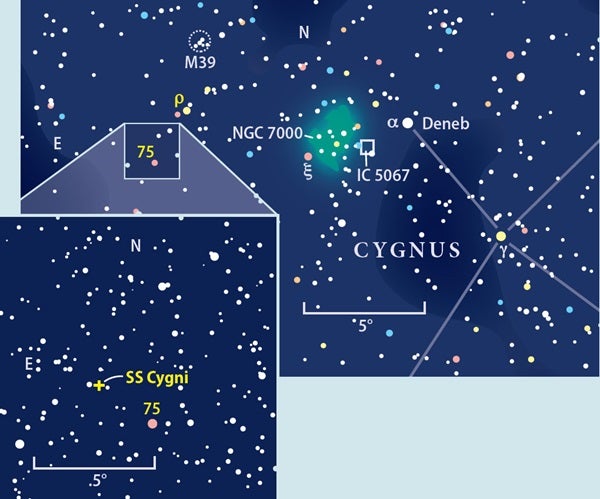My “Observing basics” column in the September issue of Astronomy features the cataclysmic variable star SS Cygni. In describing this fascinating object, I wrote:
“Since its discovery in 1896, SS Cygni has captivated astronomers. It ranks as one of the most popular objects in the American Association of Variable Star Observers’ (AAVSO) observing program.
Unlike pulsating variable stars, typified by Mira (Omicron [ο] Ceti) and Delta (δ) Cephei, SS Cygni owes its brightness changes to an interaction between the members of a close binary system: a small red star orbiting a white dwarf. Matter stolen from the former by the latter’s gravity hurtles toward the white dwarf, forming a rapidly spiraling accretion disk. Heightened activity in the accretion ring is believed to be the outburst’s catalyst.
Once in outburst, SS Cygni will remain “up” for a week or two before fading back into quiescence. Because of their explosive nature, SS Cygni and other dwarf novae, as well as novae and supernovae, are classified as cataclysmic variables (CVs).”
When the September issue hit the newsstands, SS Cygni was in its usual quiescent state — a mere 12th-magnitude flicker. Readers who heeded my call to check out SS Cygni each clear night in anticipation of its next outburst didn’t have to wait long.
Last Thursday evening, August 21, I observed SS Cygni and recorded its magnitude at 11.7. The next night, SS Cygni had jumped a nearly full magnitude to 10.8. The outburst had begun! For the past three evenings, I’ve watched SS Cygni continue to slowly brighten to magnitude 9.0 on Monday, August 25. I expect it to be even brighter tonight.
The current outburst differs from typical SS Cygni flare-ups, which usually exhibit a rise from 12th magnitude to around 8th in less than a day. Occasionally, SS Cygni takes its time, requiring several days to reach maximum. This seems to be the case this time.
If you missed this outburst, you can still catch SS Cygni in its “up” state. SS Cygni usually remains at peak brightness for a week or two before fading back to 12th magnitude. Because outbursts occur every 50 to 60 days, the next one might occur sometime in late October or early November.
Alas, my prediction in my September column that the next SS Cygni outburst would occur around the 15th was way off!
For further information on SS Cygni, refer to an AAVSO article at www.aavso.org/vstar/vsots/0600.shtml.
Glenn Chaple is a contributing editor at Astronomy magazine and writes a monthly “Observing basics” column for the publication.










